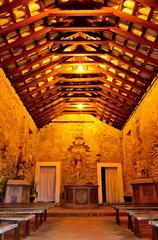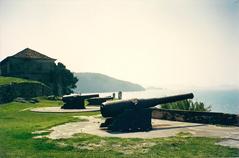Museu do Presépio: Visiting Hours, Tickets, and Guide to Florianópolis Historical Sites
Date: 14/06/2025
Introduction
The Museu do Presépio, located on the continental side of Florianópolis, Brazil, is a remarkable institution dedicated to the preservation and celebration of nativity scenes, or “presépios.” Housed in a rare colonial-era building recognized as a protected municipal heritage site, the museum offers an immersive experience into the artistry, history, and cultural significance of nativity traditions in Brazil and around the world. This guide provides comprehensive information on the museum’s visiting hours, ticketing, accessibility, collection highlights, restoration efforts, and practical travel tips for visitors.
Historical Background and Significance
Colonial Origins and Architectural Heritage
The museum is set within the last remaining “casa de chácara” (country house) of its kind on Florianópolis’s mainland. Its thick masonry walls, original woodwork, and classic colonial rooflines evoke the city’s roots and underscore the importance of cultural preservation in the face of modern urbanization. Recognized as a protected municipal heritage site, the building stands as a testament to the region’s colonial past and collective memory.
Establishment and Mission
Founded by local cultural advocates, the Museu do Presépio was created to house an expansive collection of nativity scenes and to serve as a cultural beacon for both locals and visitors. Its mission is to safeguard and promote the folk, religious, and artisanal heritage associated with presépio-making, while fostering intercultural dialogue and education.
Heritage Designation and Restoration
Despite its significance, the museum’s building faced decades of neglect. Restoration efforts, mandated by the Santa Catarina Public Prosecutor’s Office and upheld by the State Court, are preserving both the structure and its collection for future generations. This legal intervention has set an important precedent for heritage conservation in Brazil (Museu do Presépio Official Site, G1 Globo Report).
Visiting Museu do Presépio
Visiting Hours and Tickets
- Regular Hours: Tuesday to Sunday, 10:00 AM – 5:00 PM. Closed on Mondays and public holidays.
- Tickets: R$10 (adults); discounts for students, seniors, local residents; free for children under 6 and on the first Sunday of each month.
- Extended Hours: During the Christmas season (November–January), hours may extend until 9:00 PM. Check the official website for updates (Museu do Presépio Official Site).
Accessibility
The museum is wheelchair accessible, with ramps and adapted restrooms. Some areas of the historic building may have limited access; visitors with specific needs should contact the museum in advance for assistance.
Guided Tours and Special Events
- Guided Tours: Offered daily at 11:00 AM and 3:00 PM; group tours by appointment.
- Workshops & Events: Especially active during Advent and Christmas, featuring hands-on presépio-making, live nativity presentations, and educational activities for all ages.
Visitor Experience and Amenities
- Exhibitions: Over 100 nativity sets from Brazil and around the world, crafted from materials such as ceramic, bamboo, seashells, wood, bread dough, and more.
- Interactive Features: Thematic galleries, interpretive panels (primarily in Portuguese), and occasional workshops for visitors.
- Café & Gift Shop: Light snacks, coffee, and souvenirs including artisanal presépios and local crafts.
- Photo Policy: Photography is permitted without flash; respect exhibit signage.
Practical Tips
- Language: Most signage in Portuguese; translation apps recommended.
- Best Time to Visit: Weekday mornings for a quieter experience; Christmas season for special exhibits and events.
- Duration: Plan for 45–90 minutes, longer if participating in workshops or guided tours.
- Nearby Attractions: Fortaleza de São José da Ponta Grossa, Capela São João Batista, local markets, and artisan cafés (Guia Santa Catarina).
Artistic Heritage of the Presépio
Tradition and Evolution
The presépio tradition, rooted in 13th-century Italy with Saint Francis of Assisi’s first nativity scene, evolved in Brazil through Portuguese influence, blending Catholic iconography with indigenous and local artistic practices. The Museu do Presépio’s collection reflects this evolution, showcasing presépios from various Brazilian regions and international origins, each adapted to local stories and materials (G1 Globo Report).
Materials and Techniques
- Traditional: Ceramic, porcelain, wood, and metal.
- Natural: Bamboo, straw, seashells, gourds, sand, and seaweed.
- Innovative: Glass, marble, bread dough, recycled materials.
The collection’s diversity demonstrates both technical mastery and creative adaptation to local environments. Highlights include miniature presépios in matchboxes, sets in gourds and shells, and regionally themed displays from Minas Gerais, Santa Catarina, and Pernambuco, as well as international contributions from Germany, Peru, China, and more (Guia Santa Catarina).
Symbolism and Local Identity
Many presépios in the museum incorporate Azorean and local motifs, connecting the nativity story to Florianópolis’ unique cultural landscape. The use of native materials and local artisan techniques ensures that each presépio is both a religious symbol and an expression of community identity.
Restoration Efforts and Heritage Preservation
Legal and Municipal Actions
After years of structural deterioration, a judicial mandate compelled the municipality to restore the museum. Restoration is underway, focusing on preserving both the building’s colonial features and the valuable presépio collection. The process serves as a broader model for safeguarding Brazil’s cultural heritage (Museu do Presépio Official Site).
Community Engagement and Special Programs
- Workshops: Ceramic and recycled-material presépio workshops are held seasonally.
- Festival de Presépios: Annual event featuring artisans, storytellers, and musicians.
- Educational Outreach: Programs for schools and community groups promote the tradition and artistry of presépio-making (Cadastro Nacional de Museus).
Frequently Asked Questions (FAQ)
Q: What are the museum’s current hours?
A: Tuesday–Sunday, 10:00 AM–5:00 PM; closed Mondays and holidays. Extended during Christmas.
Q: How much are tickets?
A: R$10 for adults; discounts for students, seniors, and children. Free on the first Sunday of each month.
Q: Is the museum accessible for people with disabilities?
A: Yes, with ramps and adapted restrooms. Contact in advance for specific needs.
Q: Are guided tours available?
A: Yes, daily at 11:00 AM and 3:00 PM; group tours by appointment.
Q: Is photography allowed?
A: Yes, without flash.
Q: What other sites can I visit nearby?
A: Fortaleza de São José da Ponta Grossa, Capela São João Batista, local markets, and artisan cafés.
Contact Information and Reservations
- Phone: +55 48 3222-1333
- WhatsApp: 98871-9946
- Email: [email protected]
- Website: Museu do Presépio Official Site
Advance booking is recommended for group tours and workshops, especially during peak seasons.
Visuals and Online Resources
- Official Photo Galleries: Explore the collection online via the Museu do Presépio Official Site.
- Virtual Tours: Interactive maps and virtual exhibits available through local tourism portals.
- Social Media: Share your visit with #museudoflorianopolis and follow @museudeflorianopolis for news and events.
Conclusion and Traveler Tips
The Museu do Presépio is a vibrant cultural destination that brings together faith, artistry, and community spirit. Through its carefully curated collection, ongoing restoration efforts, and dynamic community programming, the museum invites visitors to discover, reflect, and connect with Brazil’s nativity tradition. For an enriched experience, check updated information before your visit, participate in a guided tour or workshop, and explore nearby historical sites to immerse yourself in the cultural tapestry of Florianópolis.
Plan your visit, share your experiences, and help preserve this unique cultural treasure for future generations.






